Trigger a AWS Lambda with a SQS message with Python
Introduction
In the context of microservices, the communication of them must be fast and realiabe. This communication can be through messages and a tool for this communication can be SQS (Simple Queue Service), a messaging service by AWS.
This project will be a example of a system that can receive a SQS message from a client, process it, and give the information to another client. As a example of this process, we’ll create a microservice in a AWS Lambda that will act when receive a SQS message. It’ll write the message in a .txt file and return all the messages when receives a HTTP call to a certain endpoint. We’ll be using AWS Lambda because it is a serverless framework, in which the idea is you don’t have to worry about servers.
Python’s library FastAPI will be used to create the API, Docker to containerize it and Poetry will be the library manager. As always, the code of the project is on my Github.
Building the API
We’ll be using FastAPI as the backend tool for this project. The package has a simple syntax and makes easy to create APIs. To create a health check route:
from fastapi import FastAPI
import json
app = FastAPI()
@app.get("/healthcheck")
def root():
return {"message": "health check"}
Calling the file main.py, Uvicorn can run this API by running the following code:
import uvicorn
if __name__ == "__main__":
uvicorn.run("main:app", host="0.0.0.0", port=8000, reload=True)
Inside the main.py file, we’ll create another route called “/records”. When the API receives a SQS message, it writes it down on a .txt file called “log.txt”. The new route retrives all of the messages in the file. The full “main.py” will be
from fastapi import FastAPI
import json
app = FastAPI()
@app.get("/healthcheck")
def root():
return {"message": "health check"}
@app.get("/records")
def root():
try:
with open('/tmp/' + "log.txt", 'r') as fp:
line = fp.readlines()
lines = [ json.loads(x.replace("\n", "").replace("'", '"')) for x in line]
b = {}
for i in range(len(lines)):
b[f"{i}"] = lines[i]
return {"messages": b}
except: #when there are no messages
return {"messages": {}}
Creating the SQS handler
To create the SQS handler, we first need to undestand how our Lambda will receive the SQS message. It will come in a JSON like this
{
"Records": [
{
"messageId": "19dd0b57-b21e-4ac1-bd88-01bbb068cb78",
"receiptHandle": "MessageReceiptHandle",
"body": "Hello world",
"attributes": {
"ApproximateReceiveCount": "1",
"SentTimestamp": "1523232000000",
"SenderId": "123456789012",
"ApproximateFirstReceiveTimestamp": "1523232000001"
},
"messageAttributes": {},
"md5OfBody": "{{{md5_of_body}}}",
"eventSource": "aws:sqs",
"eventSourceARN": "arn:aws:sqs:us-east-1:123456789012:mysqs",
"awsRegion": "us-east-1"
}
]
}
There’s a few details here. First of all, the eventSourceARN, which is the address of the SQS Queue. The second is the body of the message. For this example, we want to receive messages in the format of
{"command": "SetStatus", "client_id": "c79da7ce8e5e"}
A parser must be created to extract the data and put it in a object called Message.
from pydantic import BaseModel
import json
ARN_SOURCE = f'arn:aws:sqs:us-east-1:123456789012:triggersqs_Queue'
class Message(BaseModel):
command: str
client_id: str
class SQSHandler():
def __init__(self, ARN_SOURCE):
self.ARN_SOURCE = ARN_SOURCE
def parse_messages(self, event):
messages = [Message(**json.loads(record['body'])) for record in event.get("Records", []) if record['eventSourceARN'] == self.ARN_SOURCE]
return messages
The ideia is to create a object which will be receiving a ARN_SOURCE variable, the ARN of the SQS queue. It will only try to parse the messages from that queue and will try to parse based on the Message Class in the function parse_messages. If it can, will return an object of the Message Class. Replace the ARN_SOURCE variable with the one will create in a moment. Our handler will be then
def handler_sqs(event):
sqs_handler = SQSHandler(ARN_SOURCE)
messages = sqs_handler.parse_messages(event)
for message in messages:
open('/tmp/' + "log.txt", 'a+').write(str(message.dict()) + "\n")
It will try to parse the messages and write it down to a log.txt file. The full sqs_handler.py will be
from pydantic import BaseModel
import json
import os
ARN_SOURCE = f'arn:aws:sqs:us-east-1:123456789012:mysqs'
class Message(BaseModel):
command: str
client_id: str
class SQSHandler():
def __init__(self, ARN_SOURCE):
self.ARN_SOURCE = ARN_SOURCE
def parse_messages(self, event):
messages = [Message(**json.loads(record['body'])) for record in event.get("Records", []) if record['eventSourceARN'] == self.ARN_SOURCE]
return messages
def handler_sqs(event):
sqs_handler = SQSHandler(ARN_SOURCE)
messages = sqs_handler.parse_messages(event)
for message in messages:
open('/tmp/' + "log.txt", 'a+').write(str(message.dict()) + "\n")
That’s it for the API. We need to create the lambda_handler.py now
from mangum import Mangum
from triggersqs.main import app
from triggersqs.sqs_handler import handler_sqs
def event_handler(event, context):
if event.get("Records"):
return handler_sqs(event)
if event.get("httpMethod"):
asgi_handler = Mangum(app)
return asgi_handler(event, context)
#other handlers here
def lambda_handler(event, context):
return event_handler(event, context)
Everytime it receives a event, it will check if it’s a HTTP request (which Mangum will handle) or if it’s a SQS message (which our handler sqs_handler.py will handle). The t will be

To handle our dependencies, we can use poetry
poetry init
poetry add fastapi uvicorn mangum pydantic
We can use Docker to containerize the project
FROM public.ecr.aws/lambda/python:3.8 as build
COPY ./pyproject.toml .
COPY triggersqs/ triggersqs/
RUN pip install poetry && \
poetry config virtualenvs.create false && \
poetry install
COPY entrypoints/lambda_handler.py lambda_handler.py
CMD ["lambda_handler.lambda_handler"]
Creating the ECR and the SQS Queue
To deploy the package to a AWS Lambda, we first need to create a repository and upload the image. We can also create the SQS object here. Export your AWS Account Id to a enviroment variable called AWSACCOUNTID and run:
docker build -t triggersqs:latest -t %AWSACCOUNTID%.dkr.ecr.us-east-1.amazonaws.com/triggersqs:latest . -f Dockerfile
aws ecr create-repository --repository-name triggersqs
aws ecr get-login-password --region us-east-1 | docker login --username AWS --password-stdin 949250876409.dkr.ecr.us-east-1.amazonaws.com
aws sqs create-queue --queue-name triggersqs_Queue
docker push %AWSACCOUNTID%.dkr.ecr.us-east-1.amazonaws.com/triggersqs:latest
Creating the Lambda
We can create the Lambda in a lot a different ways, from the CLI or using some Infra as a Code tool (like Terraform). I strongly recommend the use of Terraform, mainly because you can replicate the same infrastructure in many different enviroments. For this tutorial we’ll be using the management console, mainly because of the simplicity.
A Lambda function can be created on the AWS Lambda page:
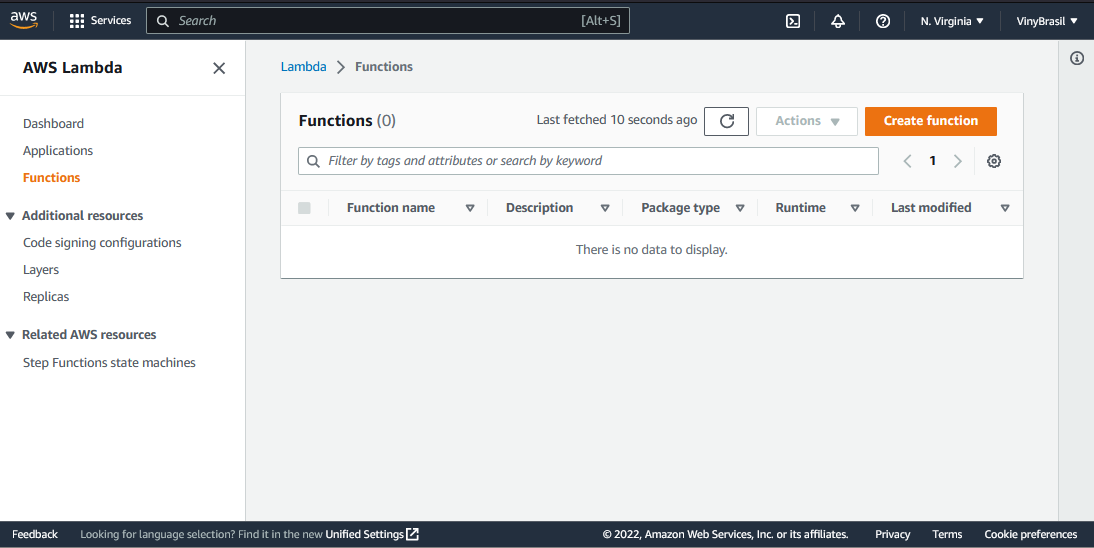
Our Lambda will use the container created before:
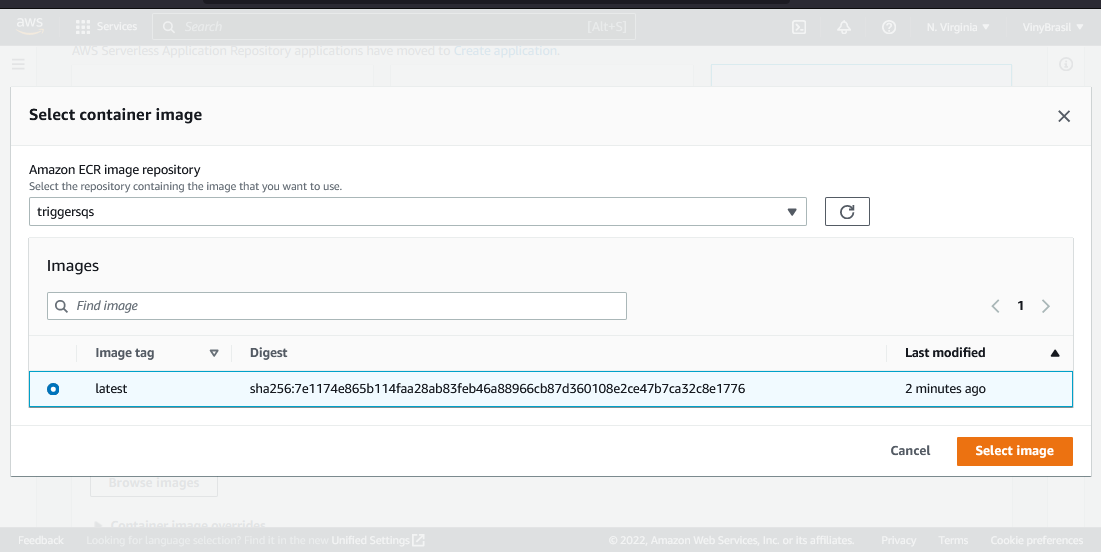
We need to give access to the SQS in the role of the Lambda. We can do this by adding:
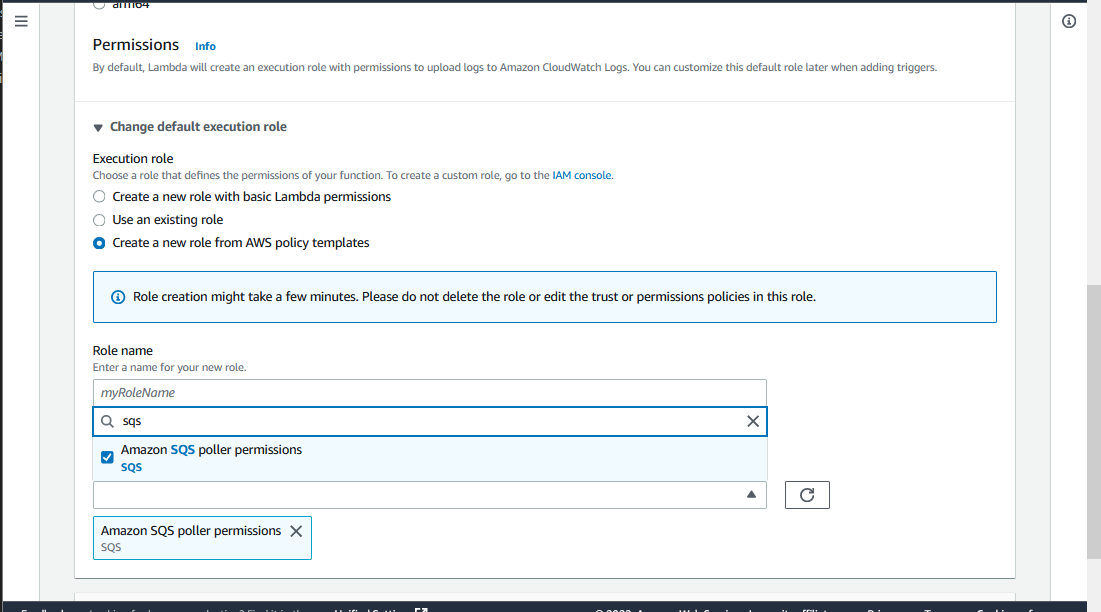
An alternative is to add full access to the SQS services on the role of the Lambda. By finding the role of the Lambda, we need to attach the following policy:
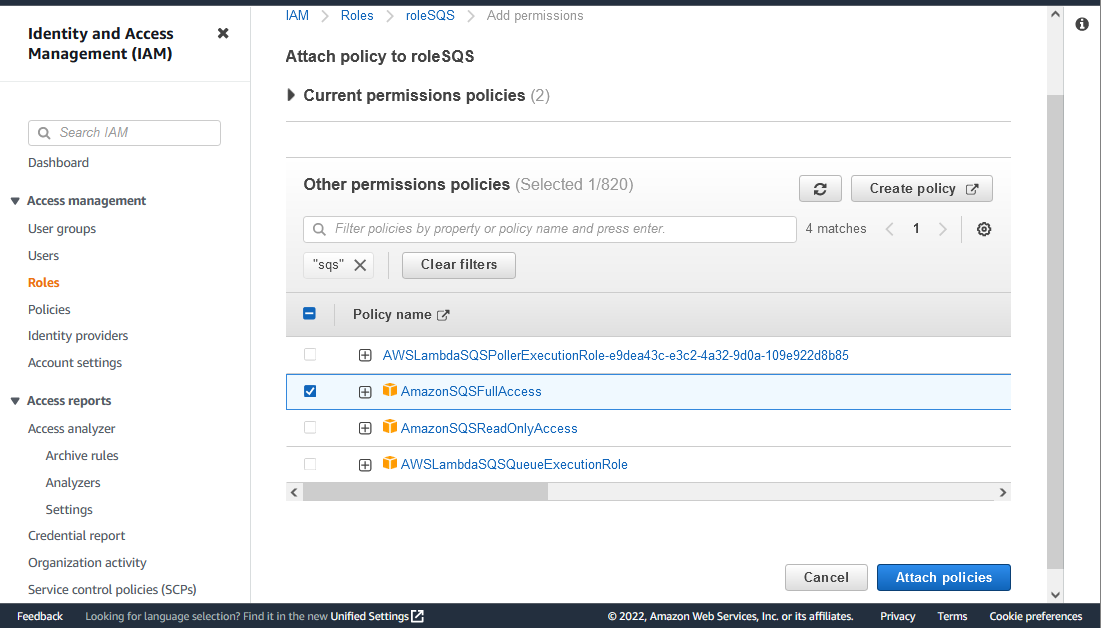
Our final Lambda should look something like this: 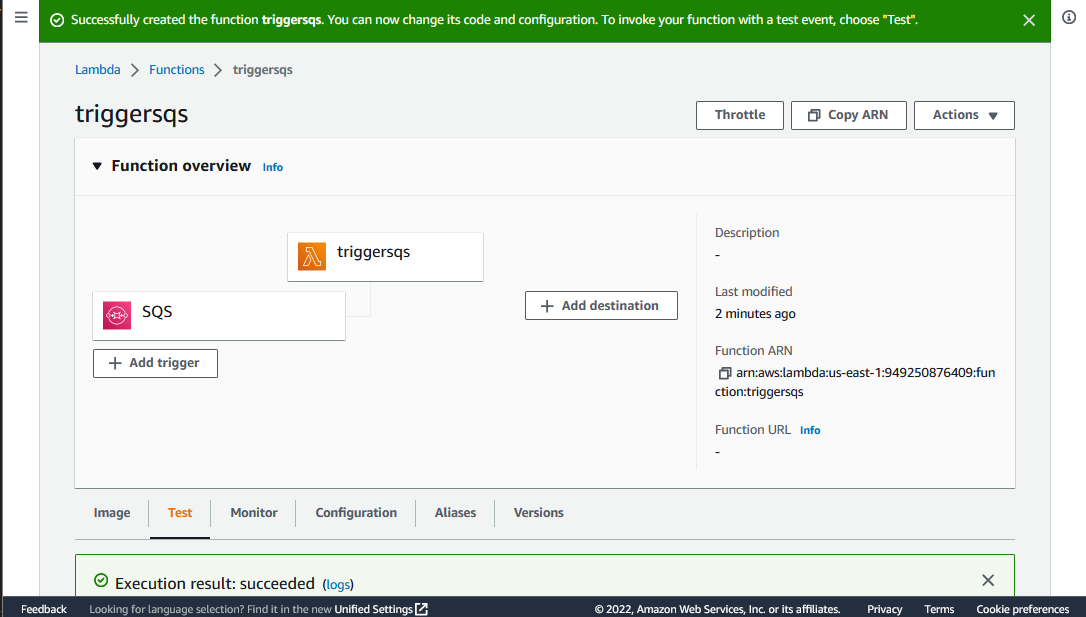
Testing
To test it, we can test it using the Test tab on the same Lambda page we are working. First, we need to test receving a SQS message:
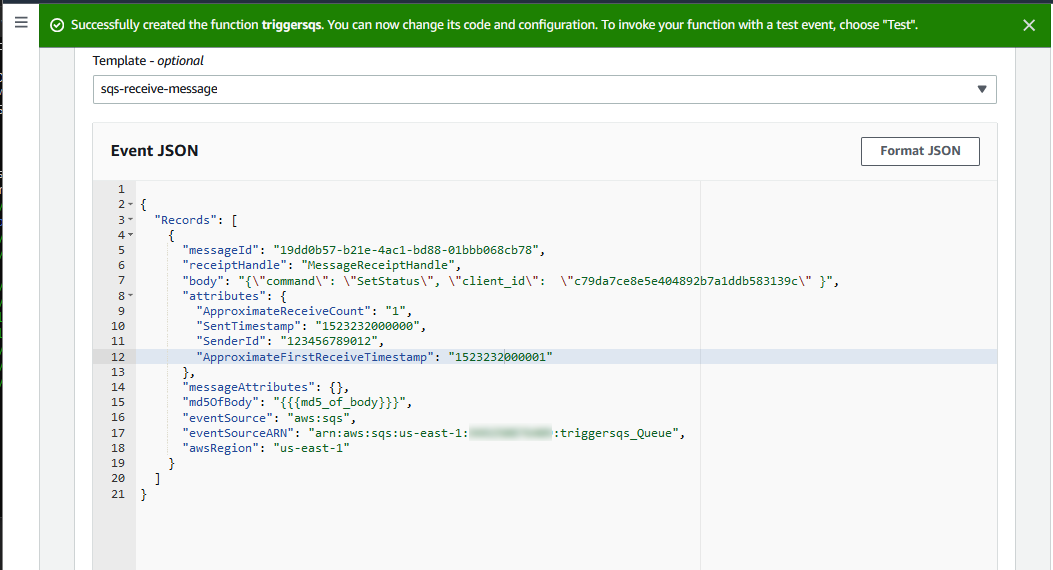
Now a API call to the endpoint /records to get all the messages: 
The response should be 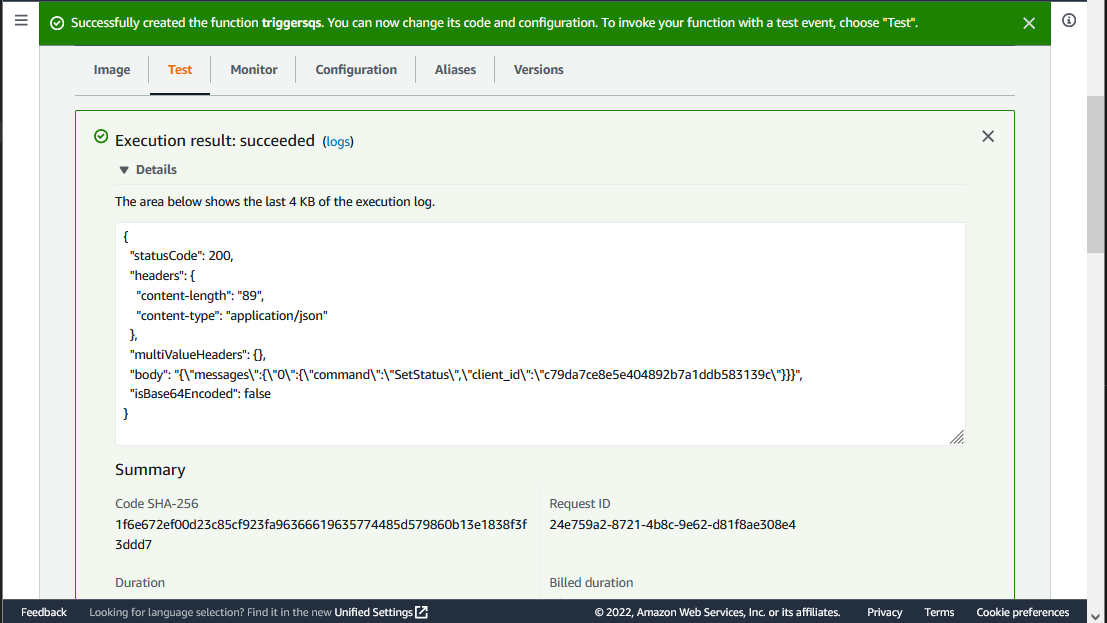
That’s it. Feel free to ask me any questions, explore the code on Github or contact me via LinkedIn. Keep on learning :D